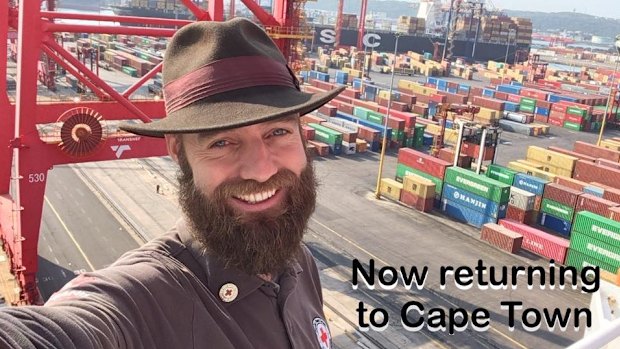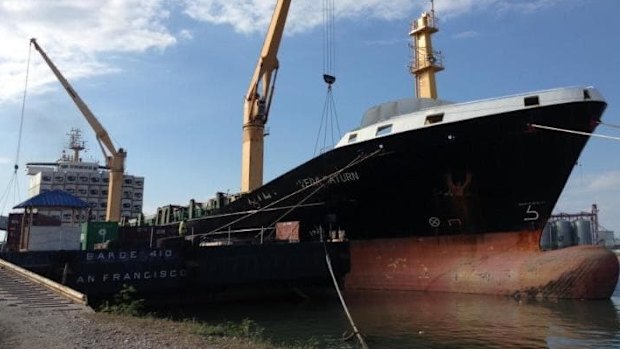This was published 7 years ago
No need for flying: The man who's travelled the world for free on cargo ships
By Soo Kim

Selfie from the ship in Durban posted to social media on 7 September 2016.Credit: Once Upon a Saga/Facebook
For globetrotters on a very tight budget, or those who love being at sea but not cruise ship crowds, travelling the world by cargo vessel could be the way forward. And for advice on the pros and cons of such a venture, there's no one better than 37-year-old Dane Torbjørn C. Pedersen, known as Thor.
Travelling as a goodwill ambassador for the Danish Red Cross, he has been sailing around the globe on container ships since October 2013, with the long-term goal of visiting every country in the world without getting on a plane. He's ticked off 122 so far, travelling through Europe, North, Central and South America, as well as the Caribbean and the Indian Ocean.
Spending at least 24 hours in every country, the current leg of his ambitious itinerary is Africa, with the latest stop being Ethiopia. The remaining 81 countries on his list entail the rest of Africa, Eastern Europe, the Middle East, Asia, and the Pacific Islands.

Thor's container ship stay in Jamaica in July. Credit: Once Upon a Saga/FacebookCredit: Once Upon a Saga/Facebook
The most memorable countries he's visited, he says, include Cuba, Iran and Greenland, where he remained for two months - the longest he's spent in any country so far.
"While it was exceedingly difficult to reach Greenland without flying it turned out to be hard to leave as well," Mr Pedersen said. "Towards my final days I nearly had the entire village texting me when there was a new boat in the port. They are such wonderful spirited people up there.
"Greenland and Cuba have surprised me the most as countries I cannot compare with others. They are absolutely unique and memorable.

Thor in Nairobi, Kenya, the most recent stop on his round-the-world trip.Credit: Once Upon a Saga/Facebook
"Cuba really stands out - culturally, historically, mentally, geographically. And Iran is a pearl of a country. It's profoundly modern in surprising ways. The architecture is spectacular and the people seem enlightened about the world in ways that embarrass outsiders from knowing so little about Iran."
14 countries everyone should see, according to Thor
- Greenland
- Cuba
- Iran
- San Marino
- Serbia
- Poland
- Iceland
- Ecuador
- Senegal
- Mali*
- Nigeria
- Gabon
- Lesotho
- Rwanda
*Note DEFAT currently advises against all travel to Mali, as well as travel to parts of Nigeria, Ecuador and Iran. Please check for travel advice at smartraveller.gov.au before travelling.
How is this epic journey possible on a budget?
While his $US20 ($A28) a day budget (paid by the oil and gas consultancy group Ross Offshore until March 2016, but now self-funded) might not seem like a lot, it covered his daily transport, meals, accommodation and visas and was put in place "to prove that travelling can be done economically and that one does not need to be a millionaire to cross borders, meet new people and make friends," according to Mr Pedersen.
"But I do have additional costs like repairs, vaccines, internet, insurance, medical checkups, nature parks, national museums, replacement of electronics, online promotions of social media and a fiancée who visits from time to time. With the additional expenses, the total costs double," he added.
"I could probably travel for less money than $US20 a day. Some countries are more expensive than others but most countries are quite cheap when you use local transportation, eat local food and stay with local people or use cheap guesthouses and dorm rooms. Visas can cost up to $US150 but you won't need one every day. It's very feasible.
"There are some parts of the world where people live on less than $US1.90 a day. So for them $US20 a day would be a fortune."
Bagging a stay on board a container ship isn't as straightforward as you might think, Mr Pederson explained. It involves a "great deal of work", from researching which ships go to which ports and how to contact the owners and operators of the ships, to writing emails to "sell" the idea of having you on board.
He added: "The ships have no incentive to carry a passenger. It's an inconvenience for the shipping line and a passenger represents an unwanted liability. You would need to express that you can be on your own and wouldn't get in the way of the crew and the operations. It would need to be clear that you can be invisible.
"It's really a lot of hit and miss. But with enough persistence and originality there's always a solution."
See also: How to be a passenger on a cargo ship
Life on board a container ship
Luxuries are usually lacking, said Mr Pedersen, but he has been pleasantly surprised by the quality of accommodation.
"I've slept on a kitchen floor of a very unclean boat, but the worst cabins have been comparable with mid-range hotel rooms. The best have been downright luxurious. I was onboard a ship which was 10 years old but still the bed was good, the walls were clean, the shower and toilet worked - I couldn't complain at all," he said.
On a few very fortunate occasions, he has been offered the owners cabin, which typically boast "large bedrooms with a double bed, a nice bathroom, a small hall and a huge living room. All decorated tastefully."
Other perks have included long, guilt-free showers because container ships "run the water past the engine, which is immensely hot, so you get hot water for free".
"Sometimes there's Wi-Fi," he added. "On one journey, I saw the Northern Lights, and I saw whales and dolphins. It's quite extraordinary sometimes. But most of the time, you just see water."
While the places he's been have been incredible, it's the people and the experiences that have left the biggest impression on Mr Pedersen, with the greatest eye-opener being how poorly the world is represented through media.
He explained: "There's an enormous focus on the horrific aspects of our world: terror, disease, corruption, conflict. While those are certainly all elements of our world it's hardly representative of where we live, the vast majority of the planet is quite trivial and almost boring. People eat, go to work, go to school, go to visit friend, get stuck in traffic, dance, listen to music, date, fall in love... complain about the weather and complain in general."
With 81 more to go, the countries he is most looking forward to seeing include Japan, Algeria, Turkey, Malta, Turkmenistan, Afghanistan, Mongolia, China and the Maldives, which will be his final destination before returning home to Denmark. Not a bad way to finish.
He added: "Now that I'm engaged I naturally also hope to start a family and get married. Certainly it will be great to see friends and family, go for a run in my neighbourhood and drink Danish milk again."
Mr Pedersen is not the first to attempt to visit every country in the world without taking a flight. Back in 2012, British traveller Graham Hughes completed a similar round-the-world trip on a shoestring budget that took him the best part of four years, and included one trip back home before continuing his expedition. Mr Hughes's claim for the record title, however, was rejected by the Guinness Book of World Records when it was reported that he'd entered Russia "illegally" across a river.
Upon completing his trip, Mr Pedersen will be the first to visit all the countries in the world on an uninterrupted journey (without taking a flight) before returning to his home country of Denmark.
See also: Travel tips: Are there still cargo ships that take passengers?
How to book container ship accommodation
Of the nine container ships Mr Pedersen has been on so far, only one chose to charge him, $US15 a day for meals and accommodation and $US60 for insurance. So if you're willing to put in the leg work, like Thor, then it's a very cheap way to travel.
For those who are willing to pay a lot more for a unique cargo vessel voyage, there are some companies that can offer passenger accommodation, such as the Italian company Grimaldi Lines (www.grimaldi-freightercruises.com), which offers voyages from Southampton to the Mediterranean, and from Tilbury to West Africa and South America, as well as Pathfinder Marine Travel (www.safemariner.co.uk).
"Generally, cargo vessels cater for less than a dozen passengers, with the stays including all meals on board, and remain in their ports of call for one to three days. Some have small swimming pools and gyms, and dinner at the captain's table is the norm. Passages may be booked for round trips lasting up to two or three months, or for segments en route," said Gavin Bell, a travel writer.
See also: What cruise ship is best for me?
In numbers | Thor's epic journey
225 - number of buses he's travelled on
98 - number of trains, minibuses, and taxis he's been on for this journey so far
81 - number of countries he's yet to visit
40 - age he'll be when he's expected to complete the journey
9.3 - average number of days he's been spending in any country
9 - number of container ships he's been on so far
2.3 - average number of years to go before completing his journey
At a glance | Tips for arranging a stay on a container ship
- Never approach the captain of the ship to arrange your stay. He will always say no and might even be offended.
- Get in touch with the company using the ship, the owners of the ship or the operators of the ship to make an enquiry.
- Express that you can be on your own and wouldn't get in the way of the crew and the operations. It would need to be clear that you can be 'invisible'.
- Sometimes you can call the port authorities or find who you need to contact on LinkedIn.
- Offer the ship something in exchange for your stay on board...i.e. write about your experience onboard and share it with the company.
- Social media helps. I always try to promote the shipping companies that support me on social media.
Source: Torbjørn C. Pedersen
Cargo vessel travel tips | Things to know before you go
- WiFi is not available on board. Some ships are hooked up, be sure to check with your agent. One way around this is to purchase a worldwide USB and then buy a new SIM card at every port. This can, however, be costly and only available for use in port, not at sea.
- If you're going ashore then use internet cafés or take your laptop to a beautifully located café…drink your latte whilst catching up on emails.
- There is no doctor on board. The vessel has a well-stocked ship's dispensary and a treatment room and the captain and officers have the necessary skills to give first aid and provide further treatment if necessary. You should bring any medication required on a daily basis with you.
- You'll be asked to provide a doctor's note two weeks prior to sailing and declare any pre-existing medical conditions. It won't necessarily preclude you from travelling, so long as your doctor provides details.
- Container ships require a certain level of fitness to board. There is a very steep gangway to enter the ship from ground level, no lift. You're not expected to carry your own luggage.
- Once on board there may or may not be a lift, depending on the flag state of the ship. Check with your agent. You will be specifically asked about any mobility issues—discuss with your agent and doctor before committing to a voyage.
- There will always be an agent that comes on board once the ship has berthed, and at a reasonable hour. They can assist you in making arrangements to spend your time effectively ashore, and be sure to be back at the ship two hours before sailing.
- Leave a mobile telephone number with the captain so he can contact you should the scheduled sailing time change.
Source: Rebecca Hall, travel writer who has previously travelled on a cargo vessel journey
The Telegraph, London
See also: The biggest cruise ship based in Australia arrives in Sydney
See also: Cruise ship rated Australia's best gets $11 million makeover
Sign up for the Traveller Deals newsletter
Get exclusive travel deals delivered straight to your inbox. Sign up now.